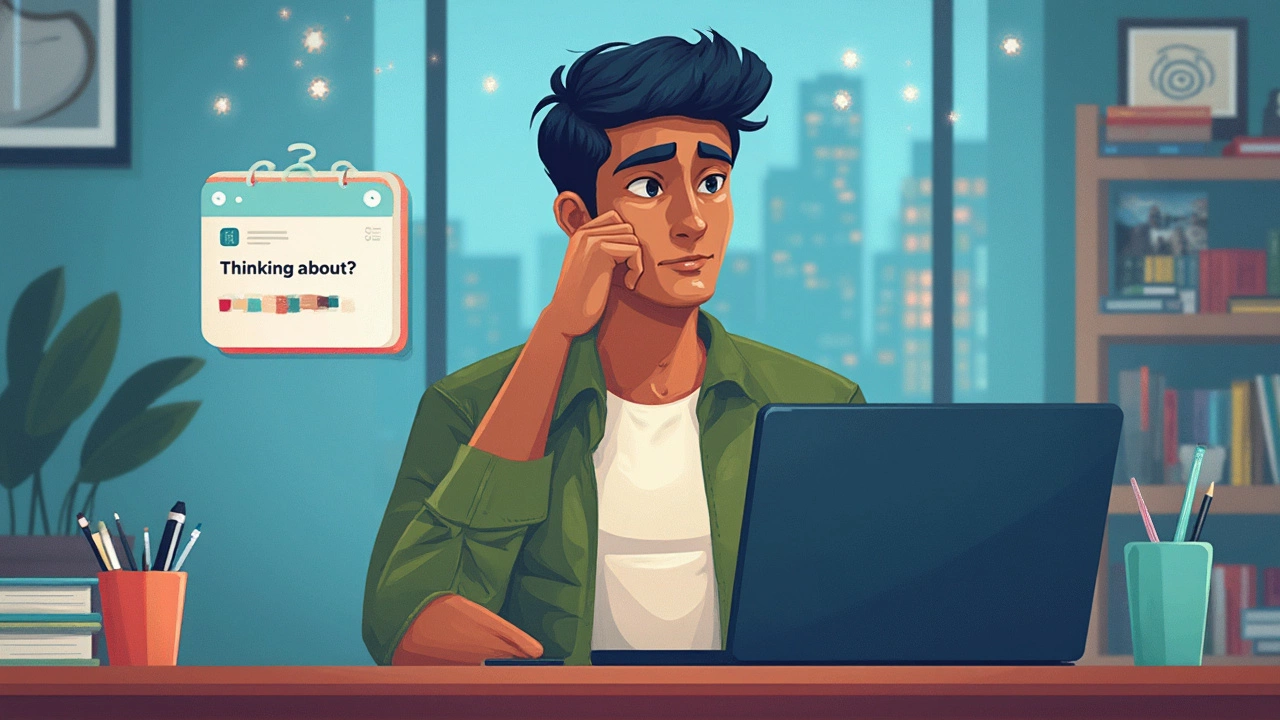Ever wonder if what you’re going through is normal stress or something bigger? Most people do. Maybe you keep replaying the same worries, wake up exhausted even after eight hours, or snap at people for no reason. If your friendships, work, or daily life start feeling heavier than you can handle, that’s not something to ignore.
There’s no “right” level of pain that qualifies for therapy. You don’t have to be in crisis. If you keep thinking, “Should I just tough this out?” or “Is this just a rough patch?”—those questions themselves are one sign therapy could help. Sometimes it’s about wanting support before little problems pile up into a mountain. Therapy isn’t just for the tough stuff; it’s for everyday stuff, too.
- Spotting the Signs You Might Need Therapy
- Busting Therapy Myths
- What Therapy Actually Looks Like
- Self-Help vs. Professional Help
- How to Start with Therapy
Spotting the Signs You Might Need Therapy
Most of us brush off stress, mood swings, or even sleepless nights—thinking, “Everyone goes through this.” The truth is, sometimes those daily struggles are your mind’s way of waving a red flag. If they've stuck around longer than a couple of weeks or they keep getting in the way of your daily routine, it’s time to pay attention.
It’s easy to miss the less obvious signs. Therapy isn’t just for people in the middle of a crisis or facing huge losses. If you notice any of these things, it might be worth reaching out for help:
- You’ve lost interest in stuff you used to love—whether it’s hobbies, hanging out, or even just watching your favorite shows.
- Your mood feels off for no clear reason. Maybe you’re extra irritable, sad, angry, or anxious, and it just won’t budge.
- Everyday tasks, like working, cleaning, or even getting dressed, suddenly feel overwhelming or pointless.
- Your sleep habits are out of whack—either you can’t fall asleep, or you can’t drag yourself out of bed in the morning.
- You’re using stuff like food, alcohol, or your phone to numb out tough feelings, and it’s starting to affect your day-to-day life.
- You’re stuck in a loop of negative self-talk or worry that you just can’t shake, no matter how hard you try.
- Your friends or family mention they’re worried about you, or you keep canceling on people to avoid social stuff.
One little-known fact: According to a CDC report from 2023, over 25% of adults said they felt persistent sadness or hopelessness for at least two weeks during the year. You’re far from alone in this, even if it feels lonely.
Here’s the thing—if you’re asking yourself whether you should talk to someone, that’s a strong sign already. Don’t wait for things to get out of control. Early signs might not seem like a big deal, but catching them now can make all the difference.
If you think you see yourself in any of these bullet points, consider setting up an initial session, just to chat. Remember, the goal of mental health therapy is to give you tools and support before stress turns into something bigger.
Busting Therapy Myths
Way too many people skip out on mental health therapy because of blue-sky myths that just don’t match reality. Thinking, "Therapy is only for crazy people" or "Talking to a therapist means I’m weak"? That’s old thinking, and it can stop you from getting actual help. Let’s crack open the truth around therapy and steer clear of those tired stereotypes.
Here are the most common myths—along with cold, hard facts:
- Myth: You have to be at rock bottom to go to therapy.
Fact: A lot of folks go to therapy for life stress, relationship problems, or just to manage anxiety. You don't have to wait until things fall apart. - Myth: Therapy is only for people with "serious" mental health issues.
Fact: Even folks doing "okayish" go to therapy. It’s not only for depression or panic attacks—people talk about sleep struggles, breakups, or feeling stuck at work. - Myth: Therapy is endless and super expensive.
Fact: Most therapists and clinics work with your budget—some even offer sliding scale fees. The average number of sessions people go to? It’s about 6–12 for short-term goals, according to the American Psychological Association. - Myth: Therapy means lying on a couch, spilling secrets, or blaming your parents for everything.
Fact: Today, therapy sessions mostly look like normal conversations. You set the pace and topics—no drama required.
Still iffy about how common therapy is? Check out this table with numbers straight from U.S. national health surveys:
| Year | Adults Who Tried Therapy (%) |
|---|---|
| 2019 | 9.5% |
| 2021 | 11.2% |
| 2023 | 13.4% |
That’s almost 1 in 7 adults in 2023! So if you’re thinking of reaching out, you’re in pretty crowded—and normal—company. Busting these myths can help you take that first step with way less baggage.

What Therapy Actually Looks Like
Therapy isn’t about lying on a couch while someone asks about your childhood (unless you want to talk about it). It’s usually a chat—sometimes video calls or even texting, since lots of therapists offer online sessions now. You talk, the therapist listens, and together you look for patterns, triggers, or simple tweaks to handle whatever’s bothering you.
Most sessions run about 50 minutes. The first one is usually about understanding what’s going on in your life. Expect some basic questions about your mood, sleep, work, relationships, and what you want to change. There’s no judgment for not having all the answers. Therapists help you figure it out, sometimes with homework or exercises you try between sessions.
Here’s what a typical therapy session might include:
- Checking in about recent life stuff (mental health check-ins are standard practice)
- Talking about what’s working and what’s not
- Trying different skills, like stress-busting techniques or better communication tips
- Setting small goals for the week
"Therapy is a partnership—someone walks alongside you, not ahead of you," says Dr. Mary K. Alvord, a psychologist and author. "You set the pace and direction."
Want cold, hard numbers? According to the American Psychological Association, about 75% of people who try therapy see some benefit. That’s not just for major problems—most people who start are dealing with everyday stuff like stress, sadness, or feeling stuck.
| Session Type | Typical Length | Available Formats |
|---|---|---|
| Individual | 50 min | In-person, online, phone |
| Group | 60-90 min | In-person, online |
| Couples/Family | 60 min | In-person, online |
Therapists are trained to help with a wide range of issues—nothing is “too small” to bring up. And anything you say stays private; therapists can’t spill your secrets unless you’re at risk of hurting yourself or someone else. It’s a safe, neutral space. That’s a big deal for people who just want to talk without judgment.
Self-Help vs. Professional Help
If you’re into podcasts or Instagram mental health tips, you’ve probably tried self-help stuff. There’s nothing wrong with that. In fact, plenty of people manage everyday stress or mood swings with things like journaling, meditation, exercise, or talking it out with friends. Apps like Headspace or Calm can teach you to relax, and there’s even solid research behind daily walks boosting your mood.
But let’s be real—sometimes self-help just scratches the surface. If you’ve been at it for weeks and things aren’t getting any better, or you feel stuck in the same negative cycle, that’s when professional help usually makes a big difference. Therapists are trained for this. They can spot patterns you might not even notice. Instead of just managing symptoms, therapy can get to the root of why you feel the way you do.
Here are a few signs your situation might call for more than self-help:
- Your sadness, anxiety, or anger doesn’t go away, or keeps getting worse.
- You’re having trouble at work or school because of how you’re feeling.
- Your sleep or eating habits have changed.
- People close to you say they’re worried.
- You start turning to things like alcohol, food, or scrolling just to escape.
Here’s a quick look at how some self-help tools compare to professional mental health therapy:
| Strategy | What It Helps With | Limitations |
|---|---|---|
| Self-Help (journaling, apps, routines) | Daily stress, minor worries, short-term mood boosts | May not help with deep-rooted problems or ongoing mental health issues |
| Professional Help (therapy, counseling) | mental health diagnoses, trauma, major life changes, ongoing struggles | Needs time commitment and sometimes insurance or payment |
If you’re not sure where you fall, it helps to try self-help for a few weeks and pay attention to any changes. But if you keep struggling, or if your problems disrupt normal life, there’s no shame in reaching out. A therapist’s job isn’t to ‘fix’ you—it’s to help you understand yourself and deal with whatever comes up. That’s something even the best podcast can’t always do.

How to Start with Therapy
Taking the first step toward therapy is the hardest part. If you’ve never done it before, it’s normal to feel awkward or even worry if you’re making a big deal out of things. But here’s what actually helps you get started, without the guesswork.
- Mental health professionals are all over the place now. You can find a therapist through your doctor, school counselors, or websites like Psychology Today and BetterHelp that let you filter by specialty, insurance, or even language spoken.
- Check your health insurance, if you have it. According to a 2023 CDC survey, 59% of Americans with private insurance had some coverage for mental health visits. This could make therapy much more affordable. If you don't have insurance, many community centers, non-profits, or online services offer discounted rates or sliding scales.
- Decide what you’re comfortable with: in-person or online? About 35% of therapy sessions in the U.S. now happen virtually, which opens up more options, especially if you live somewhere remote or just want that at-home comfort.
- Don’t stress about “sounding right” in your first session. Therapists are trained to guide you, even if all you can say is, “I don’t know where to begin.” That’s actually more common than you’d think.
- Backup your decision with data: Studies show people who attend therapy regularly report stronger relationships and better work performance. The National Alliance on Mental Illness found that about 80% of people see results within a few months, depending on what they’re working on.
Want a quick look at how people are connecting with therapists lately? Check out this breakdown:
| Therapy Method | Usage (2024, U.S.) |
|---|---|
| In-person | 53% |
| Online/Video | 35% |
| Phone/Text-based | 12% |
Remember, you don’t have to pick the perfect therapist upfront. Sometimes it takes a couple tries to find someone you vibe with. Trust your gut. If it feels off after a session or two, it’s totally normal to look elsewhere. The point isn’t to impress anyone, but just to get help, plain and simple.
